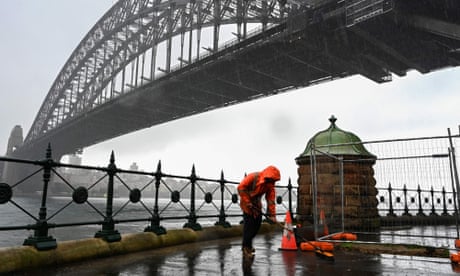- by foxnews
- 23 May 2025
Could a fourth La Niña follow Sydney’s record-breaking rainfall?
Could a fourth La Niña follow Sydney’s record-breaking rainfall?
- by theguardian
- 09 Oct 2022
- in news

Sydney's Observatory Hill has recorded the city's rainfall since 1858 but shortly after 1pm on Thursday - on another day of torrential rain - a record was washed away.
The wettest year ever for Sydney had been 1950, when 2,194 mm fell. But with almost three months still to go, that record sank.
"It's not like we've just scraped in," says meteorologist Tom Saunders, the ABC's weather forecaster for Sydney. "The record has been obliterated. I've never seen anything like it."
As well as breaking its annual record this year, the rain gauge at Observatory Hill also delivered the wettest March and July on record.
Sydney airport also broke its annual record on Thursday and by the end of September weather stations at Randwick, Bankstown and Lucas Heights had already beaten their annual records.
The rain in Sydney has been persistent, punctuated by torrential downpours that have pushed up river heights and flooded homes, suburbs and put roads and bridges underwater.
There has been rain at Observatory Hill on about 160 days so far this year. Spring, usually the driest season, has been very wet.
Three "climate drivers" have combined at different times of the year to increase the chances of rain. But the climate crisis may also have played a role.
That warmer water increases the chance of rain over northern and eastern parts in spring and summer.
Twice this year Australia has been in a negative phase of the Indian Ocean Dipole (IOD) that sees warmer waters to the continent's north-west, making more moisture available to fall as rain.
A third phenomenon, known as the Southern Annular Mode (SAM), relates to the position of the winds to the south of the continent. In a positive phase, the winds are farther south.
Saunders says SAM has been key for Sydney, as it tends to reduce the westerly winds and increase winds coming from the east "and they are the ones with all the moisture".
Guardian Australia spoke to several climate scientists who all said a warmer atmosphere, and warmer oceans, can lead to higher rainfall.
But they also said understanding specific events will require detailed modelling studies.
But statistically there is always a random chance of records being broken.
Between February and May, models hit a "predictability barrier" because of the changes in ocean temperatures. After that, forecasters get more confident about what is to come.
- by foxnews
- descember 09, 2016
United Airlines flight returns to Hawaii after concerning message found on bathroom mirror; FBI investigating
United Airlines Flight 1169 to Los Angeles returned to Hawaii after a "potential security concern" aboard the plane. The FBI and police are investigating.
read more


